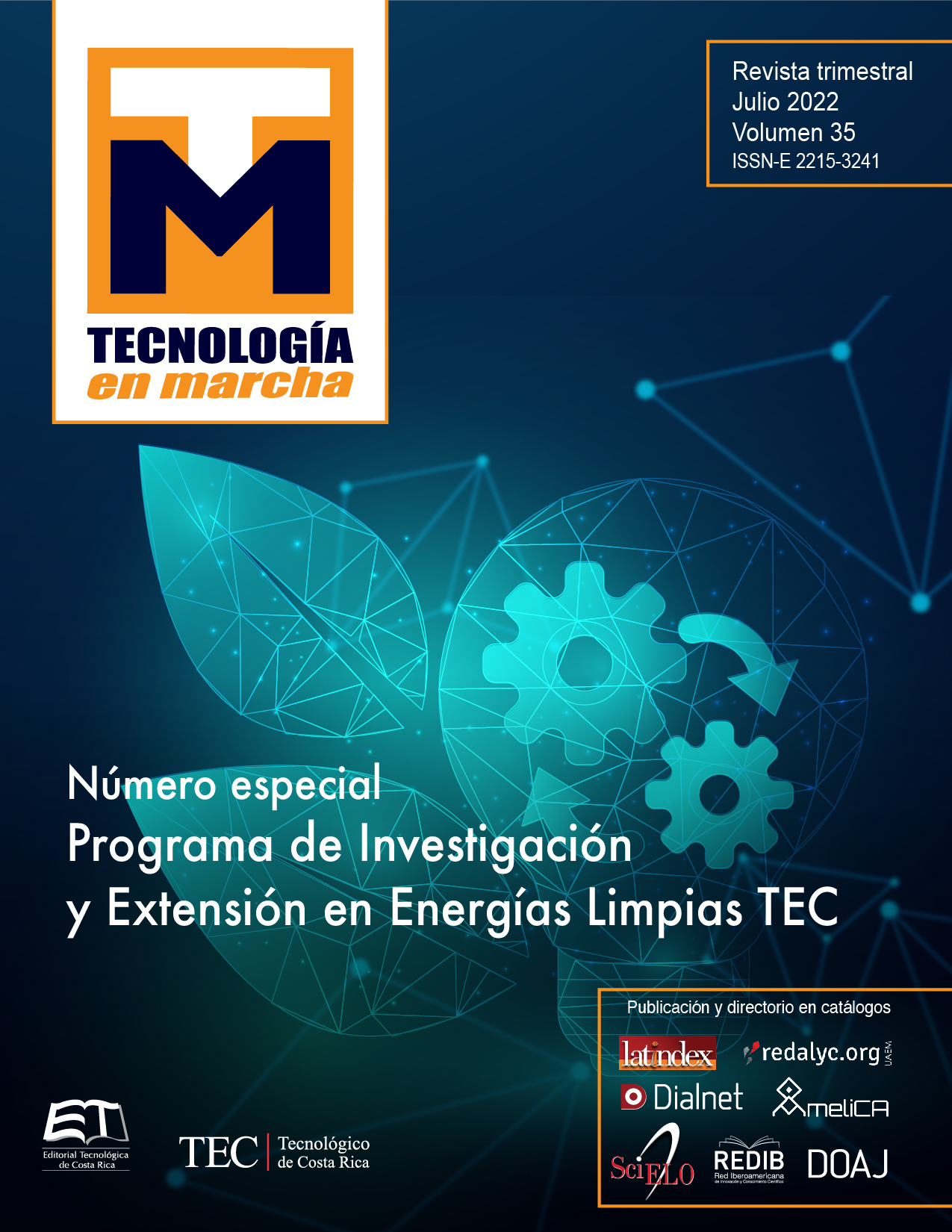Integration of an energy storage system in a wind farm, case study
Main Article Content
Abstract
Wind energy must be transformed instantaneously; it does not allow direct storage like hydroelectric energy. In a wind farm, it is possible to take advantage of the surplus energy generated during the night, when there is less demand, through an energy storage system with batteries. This work establishes the type of technology that meets the ideal characteristics, the power and energy dimensioning, as well as the financial viability of installing a battery bank in a wind farm, considering the maximum curve of the distribution network and the discharge time. It is found that a system of 2.5 MW of nominal power is required, which operates for 2.5 hours, which represents a total energy of 6.25 MWh. Lithium-Ion and Vanadium Redox Flux technologies are selected as the technologies that present the best results for this system. This selection was made considering the history of the electrical distribution system, discharge depth, annual degradation, installation configuration and energy density. Two types of installation are proposed: complete and postponed. The second allows to adapt each system according to the network and the degradation of the battery bank. It is found that the investment is around $ 8 million and it is concluded that despite being a feasible solution to the use of surpluses, under the conditions analyzed the investment is not justifiable. It is recommended to assess the investment in the future when the costs of storage technologies decrease.
Article Details

This work is licensed under a Creative Commons Attribution-NonCommercial-NoDerivatives 4.0 International License.
Los autores conservan los derechos de autor y ceden a la revista el derecho de la primera publicación y pueda editarlo, reproducirlo, distribuirlo, exhibirlo y comunicarlo en el país y en el extranjero mediante medios impresos y electrónicos. Asimismo, asumen el compromiso sobre cualquier litigio o reclamación relacionada con derechos de propiedad intelectual, exonerando de responsabilidad a la Editorial Tecnológica de Costa Rica. Además, se establece que los autores pueden realizar otros acuerdos contractuales independientes y adicionales para la distribución no exclusiva de la versión del artículo publicado en esta revista (p. ej., incluirlo en un repositorio institucional o publicarlo en un libro) siempre que indiquen claramente que el trabajo se publicó por primera vez en esta revista.
References
K. Torres-Castro, C. Torres-Quirós & G. Richmond-Navarro, “Microgeneración de energía eólica en un entorno boscoso en Costa Rica: estudio de caso,” Tecnología En Marcha, vol. 34, no. 3, p. 61-69, 2021. https://doi.org/10.18845/tm.v34i3.5063
P. Wang, Z. Gao & L. Bertling, “Operational Adequacy Studies of Power Systems With Wind Farms and Energy Storages,” IEEE Transactions on POwer Systems, vol. 27, no. 4, pp. 2377-2384, 2012. https://doi.org/10.1109/TPWRS.2012.2201181
L. Silva de Sequeira & W. Peng, “Control strategy to smooth wind power output using battery energy storage system: A review,” Journal of Energy Storage, vol. 35, p. 102252, 2021. https://doi.org/10.1016/j.est.2021.102252
J. S. Hill. (2019). GE Renewable Energy Announces New Solar + Storage Hybrid Project In New York [En línea]. Disponible https://cleantechnica.com/2019/04/17/ge-renewable-energy-announces-new-solar-storage-hybrid-project-in-new-york/
E. Ruiz, “Estudio de factibilidad técnica y viabilidad económica para el almacenamiento de energía en el Proyecto hidroeléctrico Casa de Piedra en la Zona de Los Santos,” Tesis de maestría, Instituto Tecnológico de Costa Rica, 2019.
S. N. Backhaus, M. Chertkov, & K. Dvijotham, “Operations-based planning for placement and sizing of energy storage in a grid with a high penetration of renewables,” (No. LA-UR-11-03619; LA-UR-11-3619). Los Alamos National Lab. (LANL), Los Alamos, NM (United States). 2011.
A. Berrada, A. Emrani & A. Ameur, “Life-cycle assessment of gravity energy storage systems for large-scale application,” Journal of Energy Storage, vol. 40, p. 102825, 2021. https://doi.org/10.1016/j.est.2021.102825
G.A. Gómez-Ramírez, C. Meza & S. Morales-Hernández, “Oportunidades y desafíos para la integración de almacena-miento electroquímico en las redes eléctricas centroamericanas,” Tecnología en Marcha, vol. 34, no. 3, p. 70-82, 2021. https://doi.org/10.18845/tm.v34i3.5352
A. Ramos, M. Tuovinen, M & Ala-Juusela, “Battery Energy Storage System (BESS) as a service in Finland: Business model and regulatory challenges,” Journal of Energy Storage, vol, 40, p. 102720, 2021. https://doi.org/10.1016/j.est.2021.102720
Forbes Staff. (2019). El salvador: avance del proyecto fotovoltaico Capella Solar supera el 90 % [En línea]. Disponible: https://forbescentroamerica.com/2019/12/23/el-salvador-avance-del-proyecto-fotovoltaico-capella-solar-supera-el-90/
T. Ong. (2017). Elon Musk’s giant battery is now delivering power to South Australia [En línea]. Disponible https://www.theverge.com/2017/12/1/16723186/elon-musk-battery-launched-south-australia
J. Kondoh, I. Ishii, H. Yamaguchi, A. Murata, K. Otani, K. Sakuta, N. Higuchi, S. Sekine, & M. Kamimoto, “Electrical energy storage systems for energy networks,” Energy Conversion and Management, vol. 41, no. 17, pp. 1863-1874, 2000. https://doi.org/10.1016/S0196-8904(00)00028-5
R. Dobles. (2014). Sobrecapacidad en generación eléctrica [En línea]. Disponible https://www.larepublica.net/noticia/sobrecapacidad_en_generacion_electrica
L. da Silva Lima, M. Quartier, A. Buchmayr, D. Sanjuan-Delmás, H. Laget, D. Corbisier, J. Mertens & J. Dewulf, “Life cycle assessment of lithium-ion batteries and vanadium redox flow batteries-based renewable energy storage systems,” Sustainable Energy Technologies and Assessments, vol. 46, p. 101286, 2021. https://doi.org/10.1016/j.seta.2021.101286
A. Calderón & E. Ruiz, “Revisión de dimensionamiento de capacidad y balance de energía,” Reporte técnico, DEICO, Costa Rica, 2020.
J. G. Altuve, “El uso del valor actual neto y la tasa interna de retorno para la valoración de las decisiones de inversión,” Actualidad contable FACES, vol. 7, no. 9, pp. 7-17, 2004. https://www.redalyc.org/pdf/257/25700902.pdf
M. Chaanaoui, S. Vaudreuil, & T. Bounahmidi, “Benchmark of concentrating solar power plants: Historical, current and future technical and economic development,” Procedia Computer Science, vol. 83, pp 782-789, 2016. https://doi.org/10.1016/j.procs.2016.04.167

